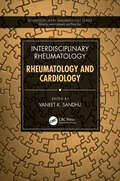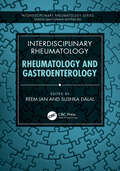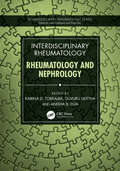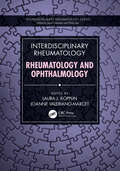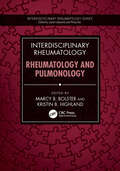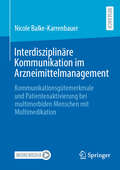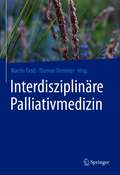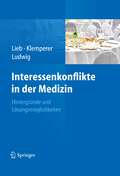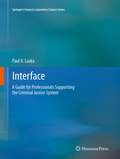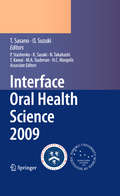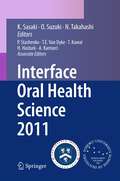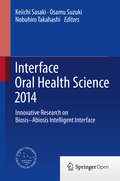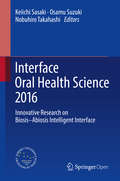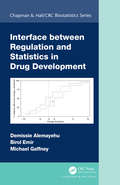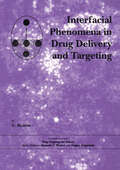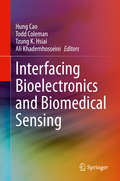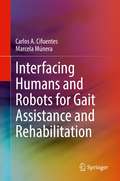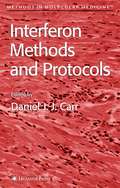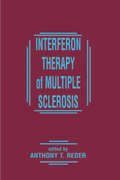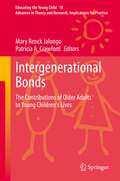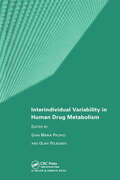- Table View
- List View
Interdisciplinary Rheumatology: Rheumatology and Cardiology (Interdisciplinary Rheumatology)
by Vaneet K. SandhuA key problem in medicine is that certain diseases may involve organ systems that cross the boundaries of individual specialties. For instance, a patient with scleroderma can develop myocarditis, or one with vasculitis can manifest with aortitis, which in turn can affect the function of the aortic valve. This book represents a dialogue between specialties, helping clinicians understand the implications of disease both within their own specialty and in the overlapping specialty of the case. Here leading experts from the fields of rheumatology and cardiology provide a masterclass in the care of patients with systemic illnesses that involve the immune system and the cardiovascular system.Key Features: Provides a clinical approach to the patient with cardiovascular manifestations of rheumatic disease. Details cutting-edge research with inputs from the world’s leading experts. Discusses possible future directions for research and advancement.
Interdisciplinary Rheumatology: Rheumatology and Gastroenterology (Interdisciplinary Rheumatology)
by Reem Jan Sushila DalalInterdisciplinary Rheumatology: Rheumatology and Gastroenterology is the first complete textbook to examine the myriad complications of rheumatic syndromes in the gastrointestinal tract. Each disease is summarized for a broad medical audience, with focus on the consequences of the disorder throughout the gut. The reader will formulate an understanding of the clinical, pharmacological, and nutritional aspects of the interface of these two specialties with expert contributors from a range of academic centers. Rheumatologists and gastroenterologists will be able to recognize, evaluate, and treat gastrointestinal symptoms of autoimmune diseases and collaborate in improving the experience and outcomes of these complex patients.
Interdisciplinary Rheumatology: Rheumatology and Nephrology (Interdisciplinary Rheumatology)
by Duvuru Geetha Anisha B. Dua Karina D. TorralbaAsk rheumatologists what is one thing that they most desire and they will say:“I wish I knew more about nephrology so I could care for patients whose rheumatologic diseases manifest with renal complications. Nephrologists feel just the same, seeking to understand the implications that autoimmune diseases have for their patients.”As part of the Interdisciplinary Rheumatology book series, this book will serve as a dialogue between rheumatologists and nephrologists and provide a masterclass from world-renowned experts on these topics. Led by a team of international editors with in-depth knowledge and cutting-edge research on topics like vasculitis and systemic lupus erythematous, among others.Key Features: Provides a clinical approach to the patient with nephrologic manifestations of rheumatic disease. Details cutting-edge research with inputs from the world’s leading experts, for both nephrologists and rheumatologists. Discusses possible future directions for research and advancement.
Interdisciplinary Rheumatology: Rheumatology and Ophthalmology (Interdisciplinary Rheumatology)
by Laura J. Kopplin Joanne Valeriano-MarcetRheumatologists routinely express a desire for a better understanding of ophthalmology to enhance their care of patients whose rheumatologic diseases manifest with ophthalmic complications. Ophthalmologists feel the same, seeking to understand the systemic impacts that autoimmune diseases have for their patients. As part of the Interdisciplinary Rheumatology book series, Interdisciplinary Rheumatology: Rheumatology and Ophthalmology is a dialogue between expert rheumatologists and ophthalmologists that provides readers with the skills to diagnose and manage a range of inflammatory eye conditions in patients with both systemic rheumatic and ocular-limited disease. With knowledge from this book, rheumatologists and ophthalmologists will be better able to collaborate effectively in the care of these complex patients.
Interdisciplinary Rheumatology: Rheumatology and Pulmonology (Interdisciplinary Rheumatology)
by Marcy B. Bolster Kristin B. HighlandCertain diseases may involve organ systems that cross the boundaries of specialties. For instance, a patient with scleroderma can develop interstitial lung disease, or a patient with relapsing polychondritis can have the clinical manifestation of subglottic stenosis. This book represents a collaboration between specialties, helping clinicians recognize the implications of disease both within their own specialty and in the overlapping specialty. Here, leading experts from the fields of rheumatology and pulmonology provide a masterclass in the care of patients with systemic illnesses that involve the immune system and the lungs.Key Features: Provides an evidence-based clinical approach to the patient with pulmonary manifestations of rheumatic disease Details cutting-edge research with input from the world’s leading experts Discusses possible future directions for research and advancement
Interdisziplinäre Kommunikation im Arzneimittelmanagement: Kommunikationsgütemerkmale und Patientenaktivierung bei multimorbiden Menschen mit Multimedikation
by Nicole Balke-KarrenbauerDie interdisziplinäre Kommunikation, vor allem an den sensiblen Versorgungs- und Informationsschnittstellen des Arzneimittelmanagements bei multimorbiden Menschen mit Multimedikation, erfordern ein hohes Maß an integrierter Interdisziplinarität. Die Berücksichtigung der identifizierten Kommunikationsgütemerkmale kann die Abstimmungsqualität in diversen Teams effektiv unterstützen. Die Patientenaktivierung wird bei multimorbiden Menschen mit Multimedikation untersucht, um die Relevanz dieses Selbstmanagement-Konzeptes hinsichtlich der patientenorientierten Unterstützung des Arzneimittelmanagements einschätzen zu können.
Interdisziplinäre Langzeitbehandlung der Adipositas- und Metabolischen Chirurgie
by Christine Stier Sonja ChiappettaDie lebenslang erforderliche Betreuung adipositaschirurgischer Patienten stellt Kollegen in der Niederlassung häufig vor die Situation, chirurgische und nutritive Komplikationen im Zusammenhang mit der vorangegangenen Operation erkennen zu müssen. Dies erfordert oft sehr spezielle Kenntnisse nicht nur der Operationsverfahren selbst, sondern insbesondere der Stoffwechselveränderungen, die der Operation folgen. Auf der Grundlage langjähriger Erfahrungen in den führenden operativen Adipositaszentren in Deutschland haben die Herausgeberinnen dieses Buch zusammengestellt. Es bietet eine praktische Anleitung für die Nachbetreuung von operierten Adipositas-Patienten. Praxisnah unterstützt das Buch den niedergelassenen Allgemeinarzt und Internisten in seiner Kompetenz, postoperative Veränderungen und Komplikationen zu erkennen und zu behandeln. Die vielfältigen und komplexen physiologischen Veränderungen werden erläutert wie auch das notwendige Wissen zu den Operationsverfahren. Es werden die Themen Ernährung, Mangelerscheinungen und Supplementation nach einer Operation, mögliche Komplikationen und Interventionsmöglichkeiten aufgezeigt. Das Monitoring einer Schwangerschaft, die einer adipositas-chirurgischen Intervention folgt, nimmt ebenfalls einen besonderen Stellenwert ein.
Interdisziplinäre Palliativmedizin
by Martin Groß Thomas DemmerDas Buch beschreibt die aktuellen Herausforderungen der Palliativmedizin bei Erwachsenen, beispielsweise in den Bereichen Organisation, gesellschaftlicher Wandel, Entscheidungsfindung, Digitalisierung sowie im Hinblick auf die Zusammenarbeit der verschiedenen Fachbereiche und Berufsgruppen im ambulanten und stationären Bereich. Die Autoren diskutieren interdisziplinäre Lösungsansätze und nehmen Kommunikation, Humor, Kreativität und Religion gleichermaßen in den Blick wie zukunftsweisende Technologien, z. B. Telemedizin und Online-Trauerberatung. Das Werk hilft Ärzten, aber auch allen anderen Mitgliedern des Palliativteams, die aktuellen Herausforderungen der Palliativmedizin zu meistern und die Patientenversorgung weiter zu verbessern.
Interessenkonflikte in der Medizin
by David Klemperer Wolf-Dieter Ludwig Klaus LiebInteressenkonflikte sind ein schwieriges Thema in der Medizin: Sehr viele Forschungsvorhaben werden vonseiten der Industrie unterstützt, so dass bei Publikationen schnell der Verdacht eines Interessenkonflikts aufkommt. Aber auch niedergelassene Ärzte und ihre Besucher vom pharmazeutischen Außendienst können von solchen Konflikten betroffen sein. In dem Band werden die Hintergründe und Lösungsmöglichkeiten bei Interessenkonflikten aus interdisziplinärer Perspektive beleuchtet.
Interface
by Paul R. LaskaA wide variety of professionals find themselves intimately involved in the criminal justice system; firefighters, emergency medical providers, nurses, physicians, public health personnel, environmental professionals, public works personnel, and many others. No previous work has attempted to address the criminal justice system in terms relevant to these professionals. Interface: A Guide for Professionals Supporting the Criminal Justice System explains the system, provides the reader with guidance to documenting incidents so that the data is both of value to the professional in the future and for use by the other components of the system. Further, this volume presents evidence from the aspect of these professionals, their needs in handling evidence, and basics of collection and preservation for those instances where it falls to them to do so. Professionals, not familiar with safety issues outside of their fields of expertise, have been injured or died as a result of exposure to hazards; it also educates them to considerations for their safety when out of their area of comfort. In addition, this book considers the role of the professional as interviewer, and provides basic guidance to this often valuable skill. Finally, Interface attempts to make the professional knowledgeable and comfortable in the courts, especially on the stand, where the professional may appear as a witness or even as an expert.
Interface Oral Health Science 2009
by Martin A. Taubman Toshihisa Kawai Osamu Suzuki Henry C. Margolis Nobuhiro Takahashi Keiichi Sasaki Takashi Sasano Philip StashenkoThe Tohoku University Graduate School of Dentistry has proposed Interface Oral Health Science as the main theme of next-generation dental research since 2002. That theme is based on the new concept that healthy oral function is provided by biological and biomechanical harmony among three systems: oral tissues, parasites, and biomaterials, and that oral diseases are interpreted as "interface diseases" caused by disruption of the intact interfaces among those systems.
Interface Oral Health Science 2011
by Keiichi SasakiInterface oral health science was founded on the concept that healthy oral function is maintained by biological and biomechanical harmony between three systems: oral tissues, parasitic oral microorganisms, and biomaterials. On that basis, dental caries, periodontal disease, and temporomandibular joint disorders may be regarded as interface disorders that result from a disruption in the intact interface of these systems. Interface oral health science encompasses the fields of dentistry and dental medicine, but also extends to general medicine, agriculture, biomaterials science, bioengineering, and pharmacology. This book is a compendium of the research presented at symposiums held in 2011 by the Tohoku University Graduate School of Dentistry and by the Forsyth Institute. Its publication is intended provide further impetus for the progress of oral science and health, pointing the way for dental research for future generations.
Interface Oral Health Science 2014
by Osamu Suzuki Nobuhiro Takahashi Keiichi SasakiThe Tohoku University Graduate School of Dentistry first introduced the concept of "Interface Oral Health Science", designed to establish and maintain healthy oral cavities, which are home to a number of mixed systems. Included in those systems are: (1) host tissues such as teeth, mucosa, muscle and bone, (2) parasites and microorganisms cohabiting the surfaces of the oral cavity and (3) biomaterials that are used for the rehabilitation of oral functions. In addition, (4) these systems are subject to severe and complex mechanical forces. Therefore, it is critical to promote dental studies that integrate a wide range of interdisciplinary research as medicine, agriculture, material science, engineering, and pharmacology. With this incentive, international symposiums for interface oral health science have been held several times in the past. The concept has since refined and expanded, the result being the "Biosis-Abiosis Intelligent Interface," and projects aiming at the creation of highly functional and autonomic intelligent interfaces are ongoing. This book brings together a number of studies on incentives and projects by leading authors. Topics include biosis-abiosis interface of dental implants, biomaterials in interface science, biomedical engineering interface and cell manipulation and tissue regeneration. Readers not only from the field of dentistry but also many related areas will find this book a valuable resource.
Interface Oral Health Science 2014: Innovative Research on Biosis-Abiosis Intelligent Interface
by Keiichi Sasaki, Osamu Suzuki and Nobuhiro TakahashiThe Tohoku University Graduate School of Dentistry first introduced the concept of “Interface Oral Health Science”, designed to establish and maintain healthy oral cavities, which are home to a number of mixed systems. Included in those systems are: (1) host tissues such as teeth, mucosa, muscle and bone, (2) parasites and microorganisms cohabiting the surfaces of the oral cavity and (3) biomaterials that are used for the rehabilitation of oral functions. In addition, (4) these systems are subject to severe and complex mechanical forces. Therefore, it is critical to promote dental studies that integrate a wide range of interdisciplinary research as medicine, agriculture, material science, engineering, and pharmacology. With this incentive, international symposiums for interface oral health science have been held several times in the past. The concept has since refined and expanded, the result being the “Biosis-Abiosis Intelligent Interface,” and projects aiming at the creation of highly functional and autonomic intelligent interfaces are ongoing. This book brings together a number of studies on incentives and projects by leading authors. Topics include biosis-abiosis interface of dental implants, biomaterials in interface science, biomedical engineering interface and cell manipulation and tissue regeneration. Readers not only from the field of dentistry but also many related areas will find this book a valuable resource.
Interface Oral Health Science 2016
by Osamu Suzuki Nobuhiro Takahashi Keiichi SasakiThis book is open access under a CC BY 4. 0 license. This volume broadens understanding of dentistry and promotes interdisciplinary research across a wide range of related fields, based on the symposium entitled "Innovative Research for Biosis-Abiosis Intelligent Interface 2016". It aims to create highly functional and autonomic intelligent interface by combining highly functional interface science with the technology of an evaluation and a control at the interface, with the various topics of biomaterials, innovation for oral science and application, regenerative oral science, and medical engineering. Since 2002, the Tohoku University Graduate School of Dentistry has hosted "Interface Oral Health Science" several times as the main theme of dental research in the twenty-first century, and this is the sixth proceedings of the symposiums following the ones in 2005, 2007, 2009, 2011, and 2014. This book benefits not only dental scientists but also other health scientists including medical physicians and pharmacologists, material scientists, engineers, and any scientist who is involved in variety of disciplines.
Interface between Regulation and Statistics in Drug Development (Chapman & Hall/CRC Biostatistics Series)
by Michael Gaffney Demissie Alemayehu Birol EmirWith the critical role of statistics in the design, conduct, analysis and reporting of clinical trials or observational studies intended for regulatory purposes, numerous guidelines have been issued by regulatory authorities around the world focusing on statistical issues related to drug development. However, the available literature on this important topic is sporadic, and often not readily accessible to drug developers or regulatory personnel. This book provides a systematic exposition of the interplay between the two disciplines, including emerging themes pertaining to the acceleration of the development of pharmaceutical medicines to serve patients with unmet needs. Features: Regulatory and statistical interactions throughout the drug development continuum The critical role of the statistician in relation to the changing regulatory and healthcare landscapes Statistical issues that commonly arise in the course of drug development and regulatory interactions Trending topics in drug development, with emphasis on current regulatory thinking and the associated challenges and opportunities The book is designed to be accessible to readers with an intermediate knowledge of statistics, and can be a useful resource to statisticians, medical researchers, and regulatory personnel in drug development, as well as graduate students in the health sciences. The authors’ decades of experience in the pharmaceutical industry and academia, and extensive regulatory experience, comes through in the many examples throughout the book.
Interfacial Phenomena in Drug Delivery and Targeting
by Graham BucktonInterfaces are of vital importance to many fields of application, but the phenomena are hard to visualise and the theories are often linked to complex mathematical models. This book, the fifth volume in the Drug Targeting and Delivery book series, provides students and working scientists with a readable text on interfacial phenomena. It does not hide away from the complex issues, but addresses the subject in a manner which will make it accessible to the scientist without previous experience of interfacial science. The book looks at a wide range of pharmaceutical issues, ranging from product development to research linked to in vivo applications.
Interfacing Bioelectronics and Biomedical Sensing
by Todd Coleman Ali Khademhosseini Hung Cao Tzung K. HsiaiThis book addresses the fundamental challenges underlying bioelectronics and tissue interface for clinical investigation. Appropriate for biomedical engineers and researchers, the authors cover topics ranging from retinal implants to restore vision, implantable circuits for neural implants, and intravascular electrochemical impedance to detect unstable plaques. In addition to these chapters, the authors also document the approaches and issues of multi-scale physiological assessment and monitoring in both humans and animal models for health monitoring and biological investigations; novel biomaterials such as conductive and biodegradable polymers to be used in biomedical devices; and the optimization of wireless power transfer via inductive coupling for batteryless and wireless implantable medical devices. In addition to engineers and researchers, this book is also an ideal supplementary or reference book for a number of courses in biomedical engineering programs, such as bioinstrumentation, MEMS/BioMEMS, bioelectronics and sensors, and more.Analyzes and discusses the electrode-tissue interfaces for optimization of biomedical devices.Introduces novel biomaterials to be used in next-generation biomedical devices.Discusses high-frequency transducers for biomedical applications.
Interfacing Humans and Robots for Gait Assistance and Rehabilitation
by Carlos A. Cifuentes Marcela MúneraThe concepts represented in this textbook are explored for the first time in assistive and rehabilitation robotics, which is the combination of physical, cognitive, and social human-robot interaction to empower gait rehabilitation and assist human mobility. The aim is to consolidate the methodologies, modules, and technologies implemented in lower-limb exoskeletons, smart walkers, and social robots when human gait assistance and rehabilitation are the primary targets. This book presents the combination of emergent technologies in healthcare applications and robotics science, such as soft robotics, force control, novel sensing methods, brain-computer interfaces, serious games, automatic learning, and motion planning. From the clinical perspective, case studies are presented for testing and evaluating how those robots interact with humans, analyzing acceptance, perception, biomechanics factors, and physiological mechanisms of recovery during the robotic assistance or therapy. Interfacing Humans and Robots for Gait Assistance and Rehabilitation will enable undergraduate and graduate students of biomedical engineering, rehabilitation engineering, robotics, and health sciences to understand the clinical needs, technology, and science of human-robot interaction behind robotic devices for rehabilitation, and the evidence and implications related to the implementation of those devices in actual therapy and daily life applications.
Interferon Methods and Protocols
by Daniel J. CarrA compendium of optimized methods to measure type I interferon efficacy as an antiproliferative or an antiviral agent. These cutting-edge techniques range from the simple to the highly complex and serve to illuminate the signaling cascades and the activation of enzymatic pathways prompted by interferon. The protocols follow the successful Methods in Molecular MedicineTM series format, each offering step-by-step laboratory instructions, an introduction outlining the principle behind the technique, lists of the necessary equipment and reagents, and tips on troubleshooting and avoiding known pitfalls. State-of-the-art and highly practical, Interferon Methods and Protocols offers researchers powerful tools not only to ascertain the functions of IFN-stimulatory gene products, but also to identify additional molecular pathways that will clarify our understanding of the many biological events influenced by IFNs.
Interferon Therapy of Multiple Sclerosis
by Anthony T. RederThis reference presents cutting-edge basic and clinical research on all forms of interferon (IFN) involvement in the management of multiple sclerosis (MS)-detailing topics from IFN-receptor molecular interactions to synergy and interference with other agents such as cytotoxic drugs and chemotherapy. Features detailed research findings on IFN-1a (
Intergenerational Analysis of Offenders and the Role of Emotional Intelligence in the Criminal Justice System (essentials)
by Otilia Gudana Sabrina StamborskiIn 1996, violence was declared and identified as a global health problem. The risk of homicide and suicide reached epidemic proportions and affected specific population groups, including youths and members of minority groups. The suicide rates among adolescents and young adults (ages 15 to 24) nearly tripled between 1950 and 1990. Similarly, the homicide rates among males aged 15 to 19 almost doubled from 1985 to 1991. These trends raised global alarm and demanded new solutions. The motivation behind this book was to compare the level of emotional intelligence of criminals in prisons and forensic psychiatric facilities. The main objective of this analysis is to focus on recommendations for emotional intelligence training to reduce the epidemic rates of violence among inmates on a global level.
Intergenerational Bonds: The Contributions of Older Adults to Young Children's Lives (Educating the Young Child #18)
by Mary Renck Jalongo Patricia A. CrawfordThis book studies the many different ways in which the lives of the first, third, and fourth generations intersect and the reciprocal benefits that can accrue from establishing positive intergenerational bonds. The unifying feature across the chapters is that the authors view these relationships as a powerful influence on Quality of Life (QoL). The book takes the stance that older adults figure prominently in the QoL of young children, with the latter group defined here as ranging in age from infancy up to and including eight years of age. It examines how bonds with older adults can affect young children’s functioning across developmental domains—physical, emotional, social, and cognitive. It addresses questions of importance to those who have a commitment to the very young such as: “What benefits can young children derive from positive bonds with older adults?”, “How do young children understand the aging process and develop respect for the elderly?”, “How can published research be used to guide both informal and formal interactions between the older generation and the newest one?” and, finally, “How can various stakeholders such as professionals, families, organizations, and communities collaborate to enrich and enlarge the kind and amount of support that older adults provide to the very young child?”
Interim Report of the Committee on Geographic Variation in Health Care Spending and Promotion of High-Value Health Care
by Institute of MedicineInterim Report of the Committee on Geographic Variation in Health Care Spending and Promotion of High-Value Health Care: Preliminary Committee Observations is designed to provide the committee's preliminary observations for the 113th Congress as it considers further Medicare reform. This report contains only key preliminary observations related primarily to the committee's commissioned analyses of Medicare Parts A (Hospital Insurance program), B (Supplementary Medical Insurance program) and D (outpatient prescription drug benefit), complemented by other empirical investigations. It does not contain any observations related to the committee's commissioned analyses of the commercial insurer population, Medicare Advantage, or Medicaid, which will be presented in the committee's final report after completion of quality-control activities. This interim report excludes conclusions or recommendations related to the committee's consideration of the geographic value index or other payment reforms designed to promote highvalue care. Additional analyses are forthcoming, which will influence the committee's deliberations. These analyses include an exploration of how Medicare Part C (Medicare Advantage) and commercial spending, utilization, and quality vary compared with, and possibly are influenced by, Medicare Parts A and B spending, utilization, and quality. The committee also is assessing potential biases that may be inherent to Medicare and commercial claims-based measures of health status. Based on this new evidence and continued review of the literature, the committee will confirm the accuracy of the observations presented in this interim report and develop final conclusions and recommendations, which will be published in the committee's final report.
Interindividual Variability in Human Drug Metabolism
by O. Pelkonen G. M. PacificiThe book provides an exhaustive, authoritative and updated review on the interindividual variability in drug metabolism in humans. Four chapters address the general background: genetic factors causing variability, interethnic variability, environmental factors and developing and ageing as sources of variability. Six chapters address variability of
